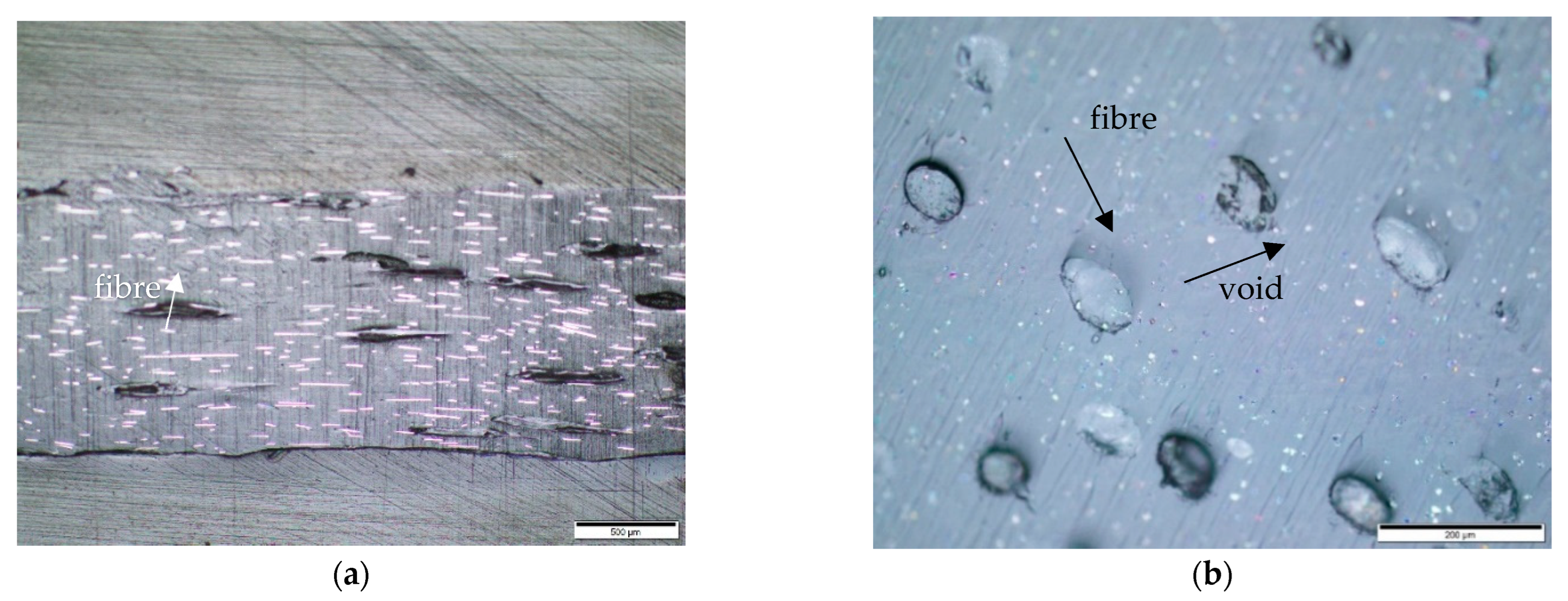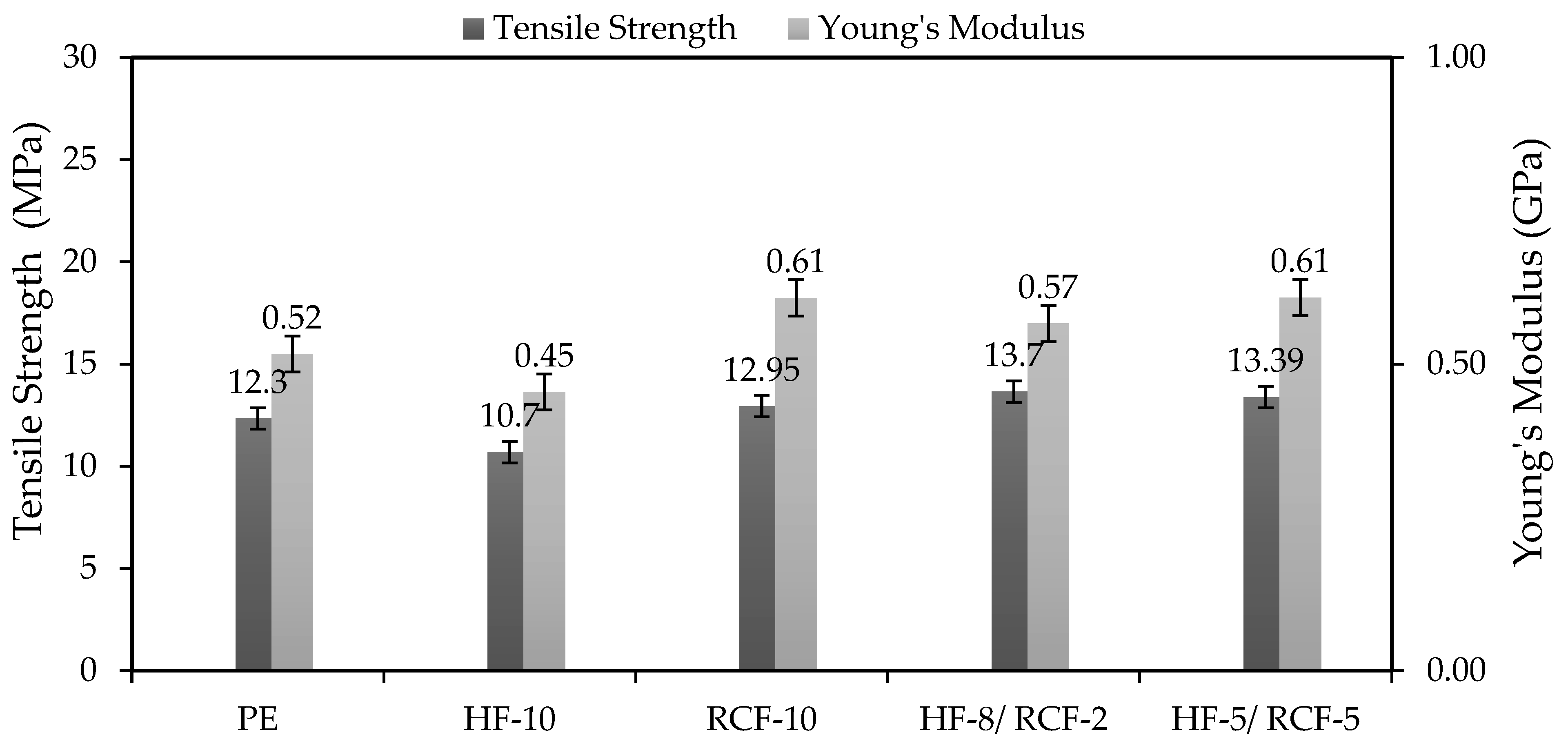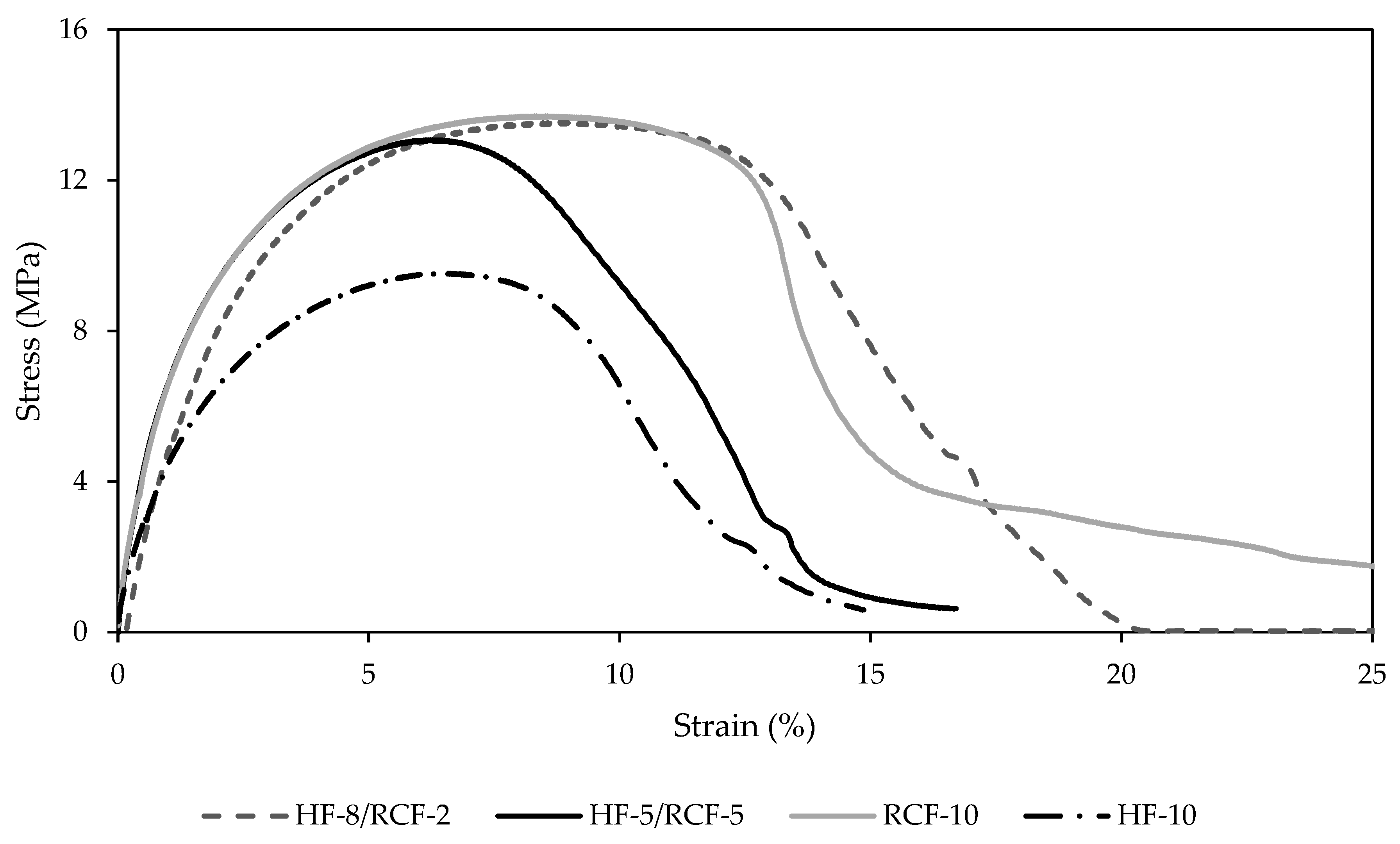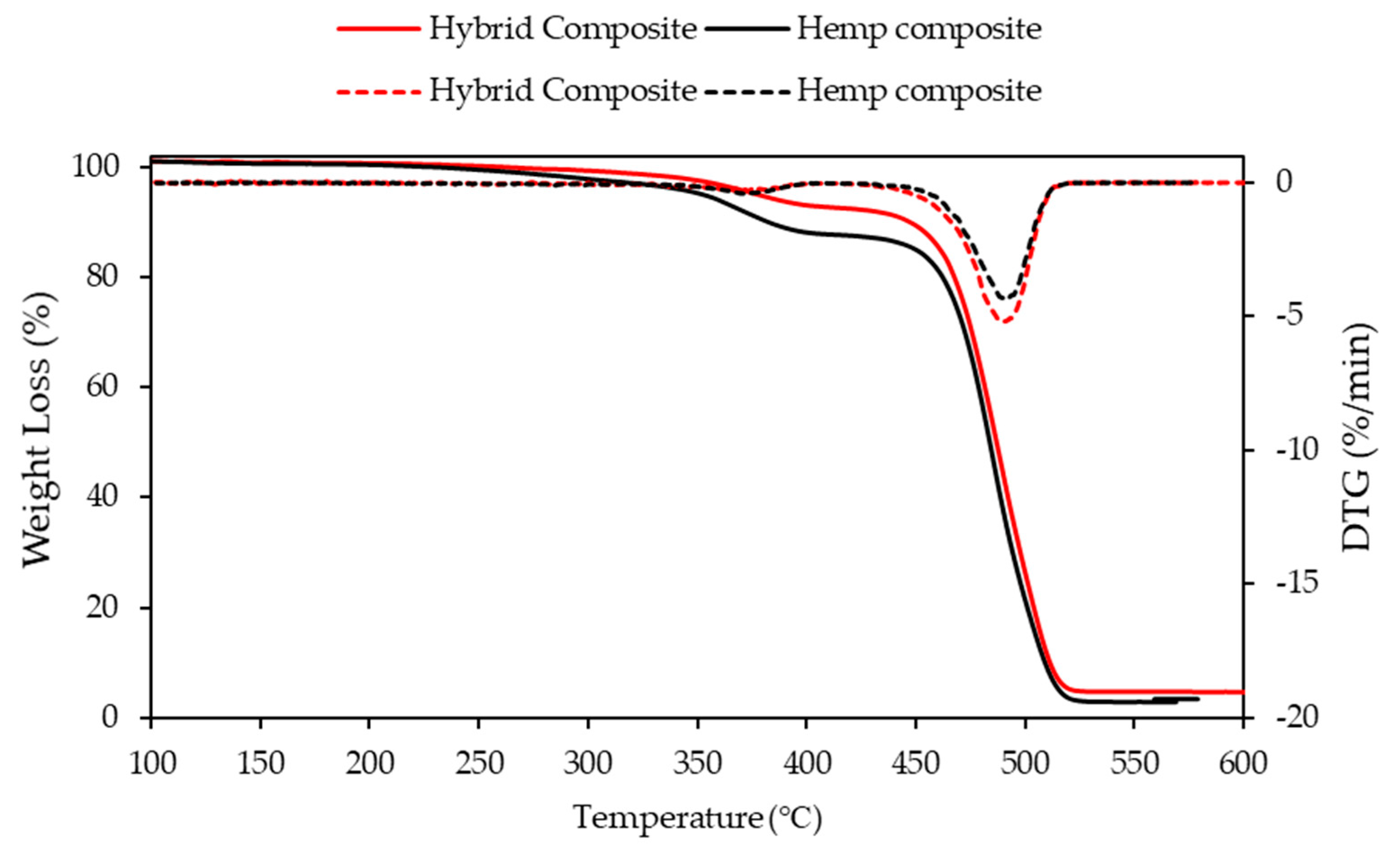Hybrid Polyethylene Composites with Recycled Carbon Fibres and Hemp Fibres Produced by Rotational Moulding
Abstract
1. Introduction
2. Materials and Methods
2.1. Materials
2.2. Methods
2.2.1. Alkali Treatment of Hemp Fibres
2.2.2. Carbon Fibre Treatment with HNO3
2.2.3. Fourier Transform Infrared Spectroscopy
2.2.4. Scanning Electron Microscopy
2.2.5. Preparation of Composites
2.2.6. Thermal Gravimetric Analysis
2.2.7. Tensile Testing of Composites
2.2.8. Porosity by Optical Microscopy
2.2.9. Statistical Analysis
3. Result and Discussion
3.1. Effect of Recycled Carbon Fibre Surface Treatment
3.2. Tensile Testing of Composites
3.3. Effect of Hybridisation on the Porosity of Rotationally Moulded Composites
3.4. Effect of Hybridisation on the Mechanical Properties of Rotationally Moulded Composites
3.5. Effect of Hybridisation on Thermal Behaviour of Composites
4. Conclusions
Author Contributions
Funding
Institutional Review Board Statement
Informed Consent Statement
Data Availability Statement
Conflicts of Interest
References
- Crawford, R.J. Practical Guide to Rotational Moulding; Smithers Rapra: Shawbury, UK, 2012. [Google Scholar]
- Crawford, R.J.; Throne, J.L. Rotational Molding Technology; William Andrew: Belfast, UK, 2001. [Google Scholar]
- Baxendale, M.; McGree, J.M.; Bellette, A.; Corry, P. Machine-based production scheduling for rotomoulded plastics manufacturing. Int. J. Prod. Res. 2021, 59, 1301–1318. [Google Scholar] [CrossRef]
- Liu, S.-J.; Peng, K.-M. Rotational molding of polycarbonate reinforced polyethylene composites: Processing parameters and properties. Polym. Eng. Sci. 2010, 50, 1457–1465. [Google Scholar] [CrossRef]
- Bhabha, H. A New Generation of High Stiffness Rotational Moulding Materials. Ph.D. Thesis, Manchester Metropolitan University, Manchester, UK, 2015. [Google Scholar]
- López-Bañuelos, R.H.; Moscoso, F.J.; Ortega-Gudiño, P.; Mendizabal, E.; Rodrigue, D.; González-Núñez, R. Rotational molding of polyethylene composites based on agave fibers. Polym. Eng. Sci. 2012, 52, 2489–2497. [Google Scholar] [CrossRef]
- Wang, B.; Panigrahi, S.; Tabil, L.; Crerar, W.J. Pre-treatment of flax fibers for use in rotationally molded biocomposites. J. Reinf. Plast. Compos. 2007, 26, 447–463. [Google Scholar] [CrossRef]
- Oliveira, M.A.; Pickering, K.L.; Sunny, T.; Lin, R.J. Treatment of hemp fibres for use in rotational moulding. J. Polym. Res. 2021, 28, 53. [Google Scholar] [CrossRef]
- Pickering, K.L.; Efendy, M.G.A.; Le, T.M. A review of recent developments in natural fibre composites and their mechanical performance. Compos. Part A Appl. Sci. Manuf. 2016, 83, 98–112. [Google Scholar] [CrossRef]
- Li, X.; Tabil, L.G.; Panigrahi, S. Chemical treatments of natural fiber for use in natural fiber-reinforced composites: A review. J. Polym. Environ. 2007, 15, 25–33. [Google Scholar] [CrossRef]
- Pickering, K. Properties and Performance of Natural-Fibre Composites; Elsevier: Cambridge, UK, 2008. [Google Scholar]
- Davoodi, M.; Sapuan, S.; Ahmad, D.; Ali, A.; Khalina, A.; Jonoobi, M. Mechanical properties of hybrid kenaf/glass reinforced epoxy composite for passenger car bumper beam. Mater. Des. 2010, 31, 4927–4932. [Google Scholar] [CrossRef]
- Thwe, M.M.; Liao, K. Durability of bamboo-glass fiber reinforced polymer matrix hybrid composites. Compos. Sci. Technol. 2003, 63, 375–387. [Google Scholar] [CrossRef]
- Mansor, M.R.; Sapuan, S.; Zainudin, E.S.; Nuraini, A.; Hambali, A. Hybrid natural and glass fibers reinforced polymer composites material selection using Analytical Hierarchy Process for automotive brake lever design. Mater. Des. 2013, 51, 484–492. [Google Scholar] [CrossRef]
- Samal, S.K.; Mohanty, S.; Nayak, S.K. Polypropylene—Bamboo/glass fiber hybrid composites: Fabrication and analysis of mechanical, morphological, thermal, and dynamic mechanical behavior. J. Reinf. Plast. Compos. 2009, 28, 2729–2747. [Google Scholar] [CrossRef]
- Samal, S.K.; Mohanty, S.; Nayak, S.K. Banana/glass fiber-reinforced polypropylene hybrid composites: Fabrication and performance evaluation. Polym. -Plast. Technol. Eng. 2009, 48, 397–414. [Google Scholar] [CrossRef]
- Aquino, E.; Sarmento, L.; Oliveira, W.; Silva, R. Moisture effect on degradation of jute/glass hybrid composites. J. Reinf. Plast. Compos. 2007, 26, 219–233. [Google Scholar] [CrossRef]
- Fiore, V.; Valenza, A.; Di Bella, G. Mechanical behavior of carbon/flax hybrid composites for structural applications. J. Compos. Mater. 2012, 46, 2089–2096. [Google Scholar] [CrossRef]
- Kore, S.; Spencer, R.; Ghossein, H.; Slaven, L.; Knight, D.; Unser, J.; Vaidya, U. Performance of hybridized bamboo-carbon fiber reinforced polypropylene composites processed using wet laid technique. Compos. Part C Open Access 2021, 6, 100185. [Google Scholar] [CrossRef]
- Ashworth, S.; Rongong, J.; Wilson, P.; Meredith, J. Mechanical and damping properties of resin transfer moulded jute-carbon hybrid composites. Compos. Part B Eng. 2016, 105, 60–66. [Google Scholar] [CrossRef]
- Flynn, J.; Amiri, A.; Ulven, C. Hybridized carbon and flax fiber composites for tailored performance. Mater. Des. 2016, 102, 21–29. [Google Scholar] [CrossRef]
- Keener, T.; Stuart, R.; Brown, T. Maleated coupling agents for natural fibre composites. Compos. Part A Appl. Sci. Manuf. 2004, 35, 357–362. [Google Scholar] [CrossRef]
- Prachayawarakorn, J.; Khunsumled, S.; Thongpin, C.; Kositchaiyong, A.; Sombatsompop, N. Effects of silane and MAPE coupling agents on the properties and interfacial adhesion of wood-filled PVC/LDPE blend. J. Appl. Polym. Sci. 2008, 108, 3523–3530. [Google Scholar] [CrossRef]
- Cisneros-López, E.O.; González-López, M.E.; Pérez-Fonseca, A.A.; González-Núñez, R.; Rodrigue, D.; Robledo-Ortíz, J.R.J. Effect of fiber content and surface treatment on the mechanical properties of natural fiber composites produced by rotomolding. Compos. Interfaces 2017, 24, 35–53. [Google Scholar] [CrossRef]
- Hanana, F.E.; Chimeni, D.Y.; Rodrigue, D.J. Morphology and mechanical properties of maple reinforced LLDPE produced by rotational moulding: Effect of fibre content and surface treatment. Polym. Compos. 2018, 26, 299–308. [Google Scholar] [CrossRef]
- Pimenta, S.; Pinho, S.T. Recycling carbon fibre reinforced polymers for structural applications: Technology review and market outlook. Waste Manag. 2011, 31, 378–392. [Google Scholar] [CrossRef] [PubMed]
- Tapper, R.J.; Longana, M.L.; Norton, A.; Potter, K.D.; Hamerton, I. An evaluation of life cycle assessment and its application to the closed-loop recycling of carbon fibre reinforced polymers. Compos. Part B Eng. 2020, 184, 107665. [Google Scholar] [CrossRef]
- Bledzki, A.K.; Seidlitz, H.; Krenz, J.; Goracy, K.; Urbaniak, M.; Rösch, J.J. Recycling of Carbon Fiber Reinforced Composite Polymers—Review—Part 2: Recovery and Application of Recycled Carbon Fibers. Polymers 2020, 12, 3003. [Google Scholar] [CrossRef] [PubMed]
- Tamburri, E.; Orlanducci, S.; Terranova, M.; Valentini, F.; Palleschi, G.; Curulli, A.; Brunetti, F.; Passeri, D.; Alippi, A.; Rossi, M. Modulation of electrical properties in single-walled carbon nanotube/conducting polymer composites. Carbon 2005, 43, 1213–1221. [Google Scholar] [CrossRef]
- Shin, S.; Jang, J.; Yoon, S.-H.; Mochida, I. A study on the effect of heat treatment on functional groups of pitch based activated carbon fiber using FTIR. Carbon 1997, 35, 1739–1743. [Google Scholar] [CrossRef]
- Moreno-Castilla, C.; López-Ramón, M.; Carrasco-Marın, F. Changes in surface chemistry of activated carbons by wet oxidation. Carbon 2000, 38, 1995–2001. [Google Scholar] [CrossRef]
- Zhang, Y.; Zhu, S.; Liu, Y.; Yang, B.; Wang, X. The mechanical and tribological properties of nitric acid-treated carbon fiber-reinforced polyoxymethylene composites. J. Appl. Polym. Sci. 2015, 132, 41812. [Google Scholar] [CrossRef]
- Tiwari, S.; Bijwe, J. Surface treatment of carbon fibers–A review. Procedia Technol. 2014, 14, 505–512. [Google Scholar] [CrossRef]
- Tiwari, S.; Bijwe, J.; Panier, S. Tribological studies on polyetherimide composites based on carbon fabric with optimized oxidation treatment. Wear 2011, 271, 2252–2260. [Google Scholar] [CrossRef]
- Meyer, L.O.; Schulte, K.; Grove-Nielsen, E. CFRP-recycling following a pyrolysis route: Process optimization and potentials. J. Compos. Mater. 2009, 43, 1121–1132. [Google Scholar] [CrossRef]
- Sharma, M.; Gao, S.; Mäder, E.; Sharma, H.; Wei, L.Y.; Bijwe, J. Carbon fiber surfaces and composite interphases. Compos. Sci. Technol. 2014, 102, 35–50. [Google Scholar] [CrossRef]
- Tian, H.; Yao, Y.; Liu, D.; Li, Y.; Jv, R.; Xiang, G.; Xiang, A. Enhanced Interfacial Adhesion and Properties of Polypropylene/Carbon Fiber Composites by Fiber Surface Oxidation in Presence of a Compatibilizer. Polym. Compos. 2019, 40, E654–E662. [Google Scholar] [CrossRef]
- Li, J.; Sun, F. The interfacial feature of thermoplastic polystyrene composite filled with nitric acid oxidized carbon fiber. Surf. Interface Anal. Int. J. Devoted Dev. Appl. Tech. Anal. Surf. Interfaces Thin Film. 2009, 41, 255–258. [Google Scholar] [CrossRef]
- Savas, L.A.; Tayfun, U.; Dogan, M. The use of polyethylene copolymers as compatibilizers in carbon fiber reinforced high density polyethylene composites. Compos. Part B Eng. 2016, 99, 188–195. [Google Scholar] [CrossRef]
- Zhou, Z.; Xu, M.; Yang, Z.; Li, X.; Shao, D. Effect of maleic anhydride grafted polyethylene on the properties of chopped carbon fiber/wood plastic composites. J. Reinf. Plast. Compos. 2014, 33, 1216–1225. [Google Scholar] [CrossRef]
- Karsli, N.G.; Aytac, A. Effects of maleated polypropylene on the morphology, thermal and mechanical properties of short carbon fiber reinforced polypropylene composites. Mater. Des. 2011, 32, 4069–4073. [Google Scholar] [CrossRef]
- Wong, K.; Mohammed, D.S.; Pickering, S.; Brooks, R. Effect of coupling agents on reinforcing potential of recycled carbon fibre for polypropylene composite. Compos. Sci. Technol. 2012, 72, 835–844. [Google Scholar] [CrossRef]
- Fu, S.-Y.; Lauke, B. Effects of fiber length and fiber orientation distributions on the tensile strength of short-fiber-reinforced polymers. Compos. Sci. Technol. 1996, 56, 1179–1190. [Google Scholar] [CrossRef]
- Karakashov, B.; Taghite, M.B.; Kouitat, R.; Fierro, V.; Celzard, A. Mechanical and thermal behavior of fibrous carbon materials. Materials 2021, 14, 1796. [Google Scholar] [CrossRef]
- Agari, Y.; Uno, T. Thermal conductivity of polymer filled with carbon materials: Effect of conductive particle chains on thermal conductivity. J. Appl. Polym. Sci. 1985, 30, 2225–2235. [Google Scholar] [CrossRef]
- Andrzejewski, J.; Krawczak, A.; Wesoły, K.; Szostak, M. Rotational molding of biocomposites with addition of buckwheat husk filler. Structure-property correlation assessment for materials based on polyethylene (PE) and poly (lactic acid) PLA. Compos. Part B Eng. 2020, 202, 108410. [Google Scholar] [CrossRef]
- Arribasplata-Seguin, A.; Quispe-Dominguez, R.; Tupia-Anticona, W.; Acosta-Sullcahuamán, J. Rotational molding parameters of wood-plastic composite materials made of recycled high density polyethylene and wood particles. Compos. Part B Eng. 2021, 217, 108876. [Google Scholar] [CrossRef]
- Dhakal, H.; Zhang, Z.; Guthrie, R.; MacMullen, J.; Bennett, N. Development of flax/carbon fibre hybrid composites for enhanced properties. Carbohydr. Polym. 2013, 96, 1–8. [Google Scholar] [CrossRef] [PubMed]











| Wavelength (cm−1) | Functional Group | Band Assignment |
|---|---|---|
| 3384 | OH | Water absorption |
| 2900 | C=H, CH2 | Stretching of the methyl and methylene groups, hydrocarbon chains |
| 1630 | C=C and C=O | Stretching vibration in conjugated carbonyl (C=O) with C=C in the graphene wall |
| 1385 | COOH | Carboxyl (COOH) group |
| 1052 | OH | O-H stretching vibration |
| Sample | Porosity (% Area) |
|---|---|
| 50(THU1.5)/50(UCU1.5) | 6.8 |
| THU1.5 | 7.7 |
| Sample | Onset Decomposition Temperature (°C) | The Temperature at the Main Decomposition Peak (°C) | Residual Char Yield (%) |
|---|---|---|---|
| Hybrid composites HF-5/RCF-5 | 385 | 500 | 4.7 |
| Hemp Composites HF-10 | 370 | 490 | 2.9 |
Publisher’s Note: MDPI stays neutral with regard to jurisdictional claims in published maps and institutional affiliations. |
© 2022 by the authors. Licensee MDPI, Basel, Switzerland. This article is an open access article distributed under the terms and conditions of the Creative Commons Attribution (CC BY) license (https://creativecommons.org/licenses/by/4.0/).
Share and Cite
Oliveira, M.; Pickering, K.L.; Gauss, C. Hybrid Polyethylene Composites with Recycled Carbon Fibres and Hemp Fibres Produced by Rotational Moulding. J. Compos. Sci. 2022, 6, 352. https://doi.org/10.3390/jcs6110352
Oliveira M, Pickering KL, Gauss C. Hybrid Polyethylene Composites with Recycled Carbon Fibres and Hemp Fibres Produced by Rotational Moulding. Journal of Composites Science. 2022; 6(11):352. https://doi.org/10.3390/jcs6110352
Chicago/Turabian StyleOliveira, Maria, Kim L. Pickering, and Christian Gauss. 2022. "Hybrid Polyethylene Composites with Recycled Carbon Fibres and Hemp Fibres Produced by Rotational Moulding" Journal of Composites Science 6, no. 11: 352. https://doi.org/10.3390/jcs6110352
APA StyleOliveira, M., Pickering, K. L., & Gauss, C. (2022). Hybrid Polyethylene Composites with Recycled Carbon Fibres and Hemp Fibres Produced by Rotational Moulding. Journal of Composites Science, 6(11), 352. https://doi.org/10.3390/jcs6110352







